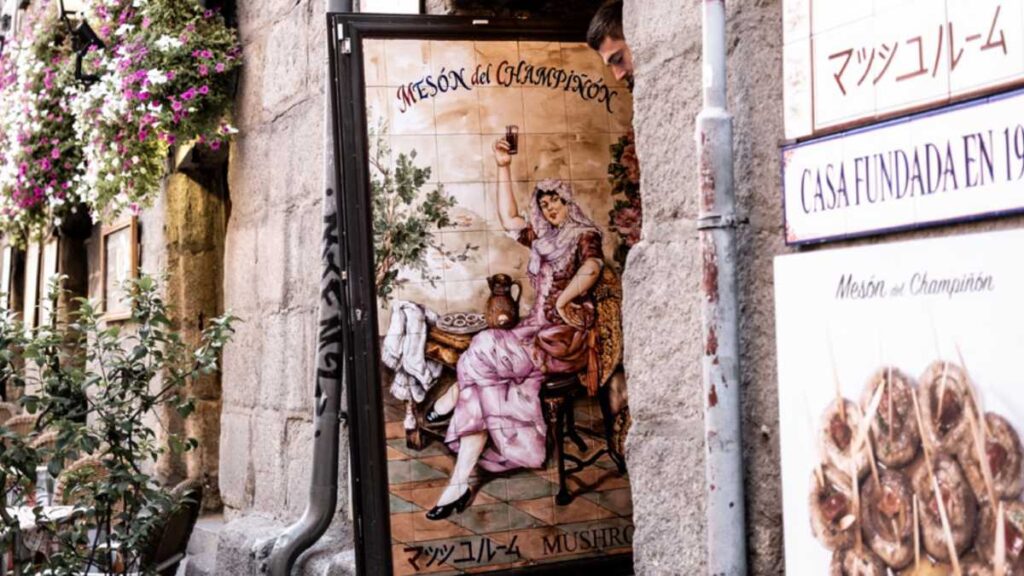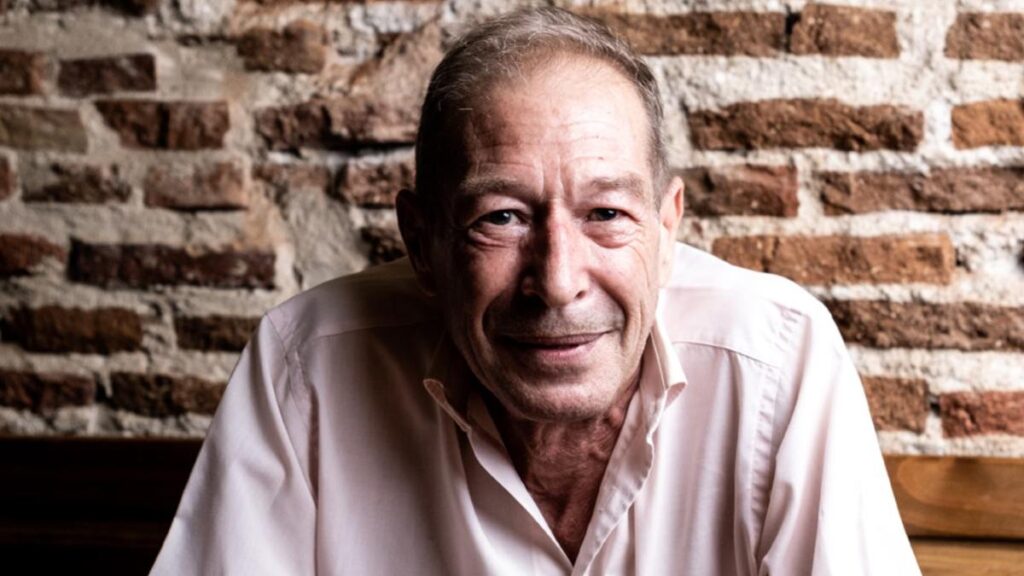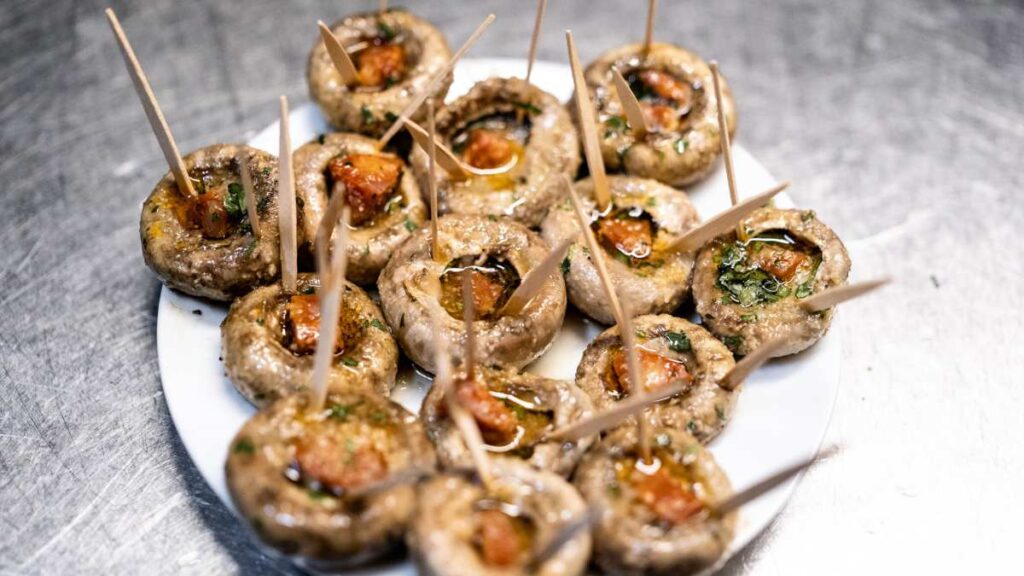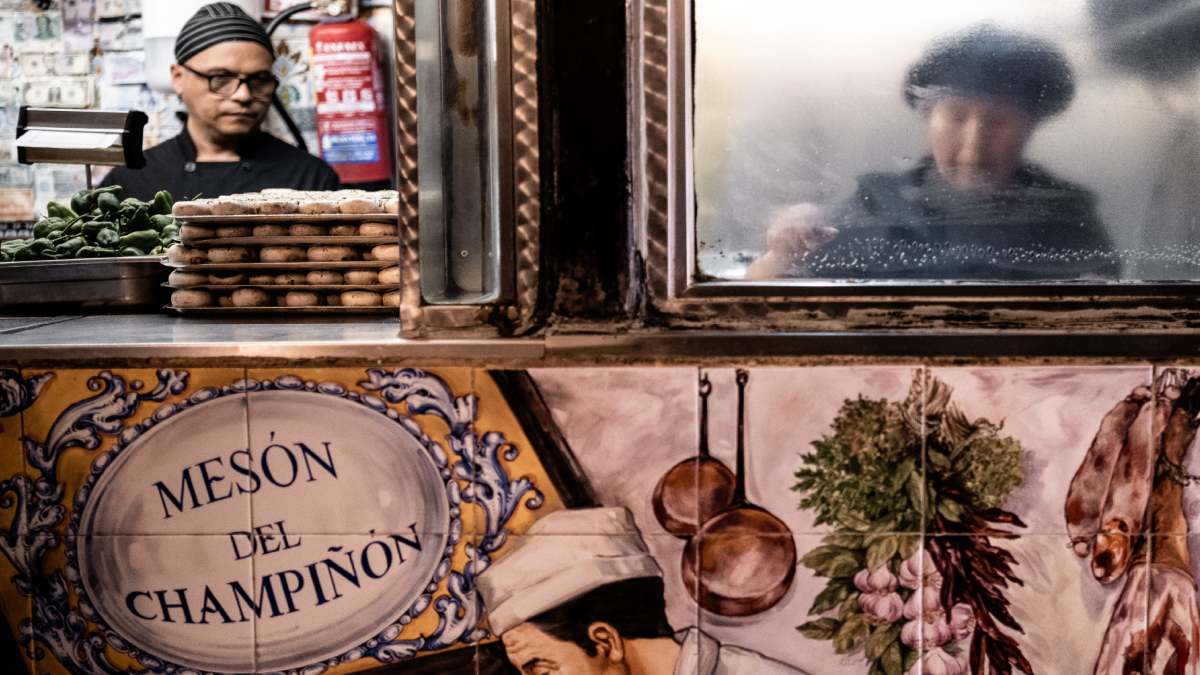Click here to read the Spanish version.
Since 1964, the calamari sandwiches in Madrid’s Plaza Mayor have shared the limelight with the grilled mushrooms they cook -with their chorizo and good stuff-, very close by, at el Mesón del Champiñón. This bar, castizo to the max, was actually born in Radio Street in the Carabanchel neighborhood, where Ángel Nieto and his brothers began to make the most delicious mushrooms in Madrid.

With time, and the success of their mushrooms, they decided to move their business to a more central location, so they went to plant their flag at number 17 Cava de San Miguel, just a few steps from the Plaza Mayor. Currently, the owner of the Mesón is Pablo Nieto, Ángel’s son. He runs the business supported by his cousin Francisco Barrera, who has been in charge of the mesón for 41 years, but the essence of the restaurant and its cuisine is exactly the same as the one left by its founder.

Francisco Barrera Nieto recibió a ‘Tapas’ en el Mesón del Champiñón el 26 de julio.
Although at El Champiñón you can eat other tapas such as Padrón peppers, croquettes, calmares, chorizo in cider or ham, mushrooms are the undisputed kings of all tables. Do not expect an extensive menu of mushroom recipes; nothing like that, here there are only two ways to eat them, the traditional one, with chorizo, or the vegetarian one, without it.
Four tons of mushrooms per year come out of his kitchen.
The recipe has varied little from the one left by Angel: mushroom, diced chorizo, chopped garlic and parsley, oil, lemon and salt. A few minutes on the grill and that’s it. They have only made a very small modification, the lemon. “Before we used lemon concentrate, now we prepare it ourselves,” says Francisco. “The advantage is that it is more natural. The disadvantage is that lemons do not always have the same acidity and sometimes we have to rectify it by adding more or less water to the juice”.

With or without lemon concentrate, with or without chorizo, this ration is so successful that an average of four tons of mushrooms a year come out of the tiny kitchen of this inn. Mushrooms of the Paris variety that they buy from the Champinter Cooperative in Villamalea (Albacete). “Until 25 years ago, during the strong seasons of the inn, we had problems of su- ministration because they were hardly cultivated. We had to solve the problem by fitting out a house we have in Ayllón (Segovia), where we are from, to grow mushrooms there. We stopped doing it and Champinter supplies them to us, we are the only ones in catering to whom they serve them”.
The reasons they use only Paris mushrooms is the flavor, milder than the same variety when it is wild, and the size. “We’re interested in having it this size so you can eat it whole and to grill it without turning it over, since it has the chorizo on top. If you use a very large mushroom, you have to keep it on the grill for so long that, in the end, the base burns,” says the manager.
The trick for them to come out juicy is in the industrial griddle: “At home, the mushrooms come out differently because they release a lot of water and remain half cooked, the fact that they are not like that on the counter is due to the griddle. With industrial griddles, the water that is released evaporates quickly. And the technique to make them taste like glory is to eat them straight, that is to say, with the two toothpicks with which they are served: “The way to eat them is to take a toothpick with each hand, open a little and eat the mushroom whole, in one bite. This way you taste them better because you don’t lose the juice or the chorizo on the plate and you don’t get stains. Sometimes they ask us for a fork and knife. We give it to them, but we warn them that it is not the same”. In fact, this particular way of eating them is an icebreaker among customers. “When someone comes in you can tell if they are new or not because they don’t know how to eat them. And if they don’t know how to get their hands on the dish, there is always someone nearby to explain the best way to do it. A lot of times they start a conversation that way.”
50% of customers are Asian
A conversation in Spanish or in other languages, because since the former Japanese emperor Hirohito visited the Mesón del Champiñón in the 1970s, approximately 50 percent of the daily clientele is Asian. “When the emperor was here, he came with televisions and media from Japan and since then, several times a month we are featured in the Japanese press. The Japanese brought the Korean public and the Koreans brought the Chinese customer, so we started translating the menu for them. Even 10 years ago, some chefs from a Tokyo restaurant who also work with mushrooms came here for a week to learn how to make mushrooms like us.
Another day, an American customer gave them a two-dollar bill, considered a good luck bill. He signed it and it was hung on one of the walls of the counter. “This happened this year and from that moment on, many customers from other countries sign a bill and give it to us as a souvenir of their visit. At this rate, we won’t be able to fit the bills on that wall.” Details from customers they match with other souvenirs they have available. “We have some mugs that say Mesón del Champión that have a price in case someone wants to take it as a souvenir, but the truth is that we often give them away to customers who have passed through here.”
Longtime customers and tourists share space at the entrance bar or take their drinks, without reservation, at the tables of the two dining rooms available. One of these spaces has been recently recovered and is less busy. In the liveliest one, on the street level, a pianist spices up the visit -and the mushrooms- with live music.
Where? At 17 Cava de San Miguel Street, Madrid.
Photos: Sara Castaño

